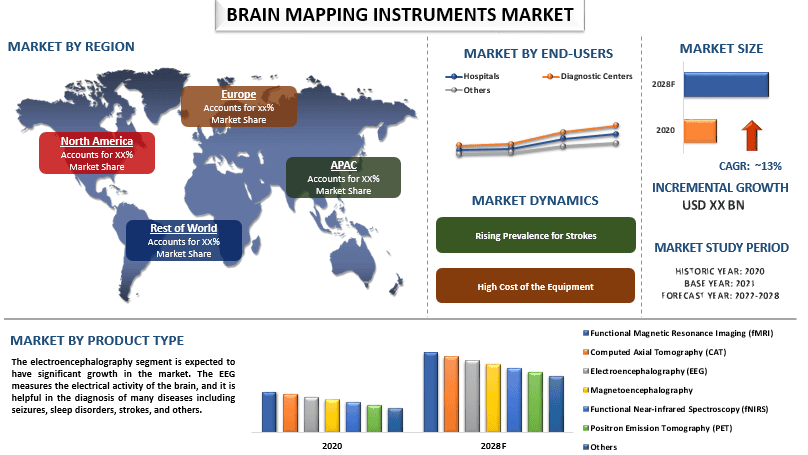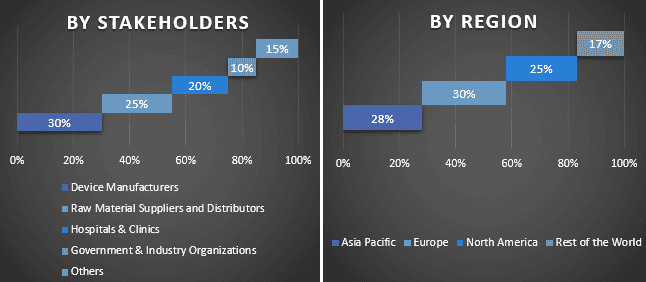- Home
- About Us
- Industry
- Services
- Reading
- Contact Us
Brain Mapping Instruments Market: Current Analysis and Forecast (2022-2028)
Emphasis on Product type (Functional Magnetic Resonance Imaging (fMRI), Computed Axial Tomography (CAT), Electroencephalography (EGG), Magnetoencephalography, Functional Near-Infrared Spectroscopy (fNIRS), Positron Emission Tomography (PET), and Others); End-users (Hospitals, Diagnostic Centers, and Others); Region (North America, Europe, Asia-Pacific, Rest of the World); and Region/Country

The global brain mapping instruments market is expected to grow at a significant rate of around 13% during the forecast period. Brain mapping is a procedure that records electrical activity within the brain. brain maps show us which brain systems are out of balance along with where the imbalances are located. The rising prevalence of chronic brain disorders and migraine cases is attributed to the growth of the brain mapping instrument market. For instance, according to World Health Organization (WHO), in September 2021 more than 55 million people live with dementia worldwide, and there are nearly 10 million new cases every year
Medtronic, General Electric Company, Koninklijke Philips N.V., Siemens Healthcare Private Limited, Advanced Brain Monitoring Inc., Natus Medical, Inc., Covidien PLC., Nihon Kohden Corporation, Canon Medical Systems Corp., and Cadwell Industries Inc are some of the key players in the market. Several M&As along with partnerships have been undertaken by these players to facilitate customers with hi-tech and innovative products/technologies.
Insights Presented in the Report
“Amongst product type, electroencephalography category to witness higher CAGR during the forecast period”
Based on the product type, the market has been categorized into functional magnetic resonance imaging (fMRI), computed axial tomography (CAT), electroencephalography (EGG), magnetoencephalography, functional near-infrared spectroscopy (fNIRS), positron emission tomography (PET), and others. The electroencephalography (EGG) category is to witness a higher CAGR during the forecast period. An electroencephalogram (EEG) is a test that measures electrical activity in the brain using a small, electrode attached to the scalp. Frequent product launches and advancements in EEG technology the important reasons for the significant market share of the segment. For instance, in October 2021, Brain Scientific Inc. obtained U.S. Food and Drug Administration clearance for its next-gen NeuroCap device, an advanced electroencephalogram (EEG) electrode array to obtain rapid EEGs in routine clinical and research settings.
“Amongst end-users, the diagnostic centers to hold a significant share in the market in 2020”
Based on the end-users, the market has been categorized into hospitals, diagnostic centers, and others. Among them, the diagnostic centers segment is expected to have significant growth in the market. The presence of specialized professionals along with the presence of a range of diagnostic equipment is attributed to the segmental growth of the diagnostic centers in the brain mapping instrument market. Moreover, the increasing investments in diagnostic centers are also an important factor in the growth of diagnostic centers.
“North America to hold a significant share in the market”
For a better understanding of the market adoption of the brain mapping instruments industry, the market is analyzed based on its worldwide presence in the countries such as North America (United States, Canada, and the Rest of North America), Europe (Germany, France, Italy, Spain, United Kingdom and Rest of Europe), Asia-Pacific (China, Japan, India, Australia, and Rest of APAC), and Rest of World. In 2020, North America held a significant share of the global brain mapping instruments market. This is mainly attributed to the rising number of product launches and the increasing healthcare investments in the region. For instance, in September 2021, Siemens NAEOTOM Alpha got FDA approval and is designed to transform the information from X-ray photons that pass through a patient’s body, and are received by a detector, into a detailed 3-dimensional image.
Reasons to buy this report:
- The study includes market sizing and forecasting analysis validated by authenticated key industry experts.
- The report presents a quick review of overall industry performance at one glance.
- The report covers an in-depth analysis of prominent industry peers with a primary focus on key business financials, product portfolio, expansion strategies, and recent developments.
- Detailed examination of drivers, restraints, key trends, and opportunities prevailing in the industry.
- The study comprehensively covers the market across different segments.
- Deep dive regional level analysis of the industry.
Customization Options:
The global brain mapping instruments market can further be customized as per the requirement or any other market segment. Besides this, UMI understands that you may have your own business needs, hence feel free to connect with us to get a report that completely suits your requirements.
Table of Content
Research Methodology for the Brain Mapping Instruments Market Analysis (2022-2028)
Analyzing the historical market, estimating the current market, and forecasting the future market of the global brain mapping instruments market were the three major steps undertaken to create and analyze the adoption of brain mapping instruments in major regions globally. Exhaustive secondary research was conducted to collect the historical market numbers and estimate the current market size. Secondly, to validate these insights, numerous findings and assumptions were taken into consideration. Moreover, exhaustive primary interviews were also conducted, with industry experts across the value chain of the global brain mapping instruments market. Post assumption and validation of market numbers through primary interviews, we employed a top-down/bottom-up approach to forecasting the complete market size. Thereafter, market breakdown and data triangulation methods were adopted to estimate and analyze the market size of segments and sub-segments of the industry pertains to. Detailed methodology is explained below:
Analysis of Historical Market Size
Step 1: In-Depth Study of Secondary Sources:
Detail secondary study was conducted to obtain the historical market size of the brain mapping instruments market through company internal sources such as annual reports & financial statements, performance presentations, press releases, etc., and external sources including journals, news & articles, government publications, competitor publications, sector reports, third-party database, and other credible publications.
Step 2: Market Segmentation:
After obtaining the historical market size of the brain mapping instruments market, we conducted a detailed secondary analysis to gather historical market insights and share for different segments & sub-segments for major regions. Major segments are included in the report as product type and end-users. Further country-level analyses were conducted to evaluate the overall adoption of testing models in that region.
Step 3: Factor Analysis:
After acquiring the historical market size of different segments and sub-segments, we conducted a detailed factor analysis to estimate the current market size of the brain mapping instruments market. Further, we conducted factor analysis using dependent and independent variables such as product type and end-users of brain mapping instruments. A thorough analysis was conducted for demand and supply-side scenarios considering top partnerships, mergers and acquisitions, business expansion, and product launches in the brain mapping instruments market sector across the globe.
Current Market Size Estimate & Forecast
Current Market Sizing: Based on actionable insights from the above 3 steps, we arrived at the current market size, key players in the global brain mapping instruments market, and market shares of the segments. All the required percentage shares split, and market breakdowns were determined using the above-mentioned secondary approach and were verified through primary interviews.
Estimation & Forecasting: For market estimation and forecast, weights were assigned to different factors including drivers & trends, restraints, and opportunities available for the stakeholders. After analyzing these factors, relevant forecasting techniques i.e., the top-down/bottom-up approach were applied to arrive at the market forecast for 2028 for different segments and sub-segments across the major markets globally. The research methodology adopted to estimate the market size encompasses:
- The industry’s market size, in terms of revenue (USD) and the adoption rate of the brain mapping instruments market across the major markets domestically
- All percentage shares, splits, and breakdowns of market segments and sub-segments
- Key players in the global brain mapping instruments market in terms of products offered. Also, the growth strategies adopted by these players to compete in the fast-growing market
Market Size and Share Validation
Primary Research: In-depth interviews were conducted with the Key Opinion Leaders (KOLs) including Top Level Executives (CXO/VPs, Sales Head, Marketing Head, Operational Head, Regional Head, Country Head, etc.) across major regions. Primary research findings were then summarized, and statistical analysis was performed to prove the stated hypothesis. Inputs from primary research were consolidated with secondary findings, hence turning information into actionable insights.
Split of Primary Participants in Different Regions

Market Engineering
The data triangulation technique was employed to complete the overall market estimation and to arrive at precise statistical numbers for each segment and sub-segment of the global brain mapping instruments market. Data was split into several segments & sub-segments post studying various parameters and trends in the areas of product type and end-users in the global brain mapping instruments market.
The main objective of the Global Brain mapping instruments Market Study
The current & future market trends of the global brain mapping instruments market were pinpointed in the study. Investors can gain strategic insights to base their discretion for investments on the qualitative and quantitative analysis performed in the study. Current and future market trends determined the overall attractiveness of the market at a regional level, providing a platform for the industrial participant to exploit the untapped market to benefit from a first-mover advantage. Other quantitative goals of the studies include:
- Analyze the current and forecast market size of the brain mapping instruments market in terms of value (USD). Also, analyze the current and forecast market size of different segments and sub-segments
- Segments in the study include areas of product type and end-users.
- Define and analysis of the regulatory framework for the brain mapping instruments industry.
- Analyze the value chain involved with the presence of various intermediaries, along with analyzing customer and competitor behaviors of the industry.
- Analyze the current and forecast market size of the brain mapping instruments market for the major region.
- Major countries of regions studied in the report include Asia Pacific, Europe, North America, and the Rest of the World.
- Company profiles of the brain mapping instruments market and the growth strategies adopted by the market players to sustain in the fast-growing market
- Deep dive regional level analysis of the industry
Related Reports
Customers who bought this item also bought










